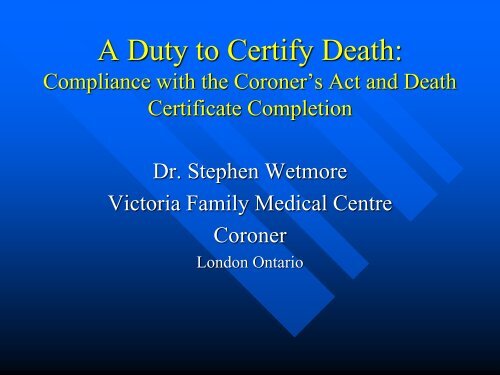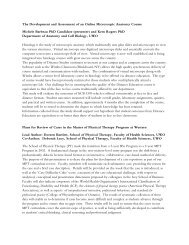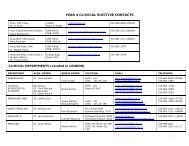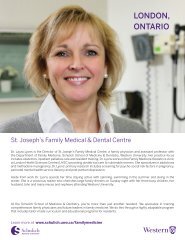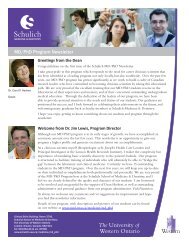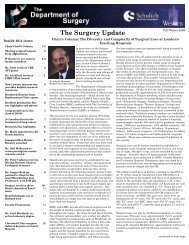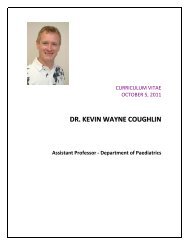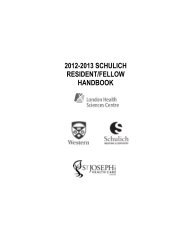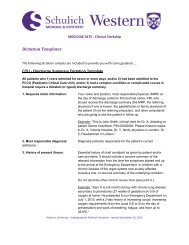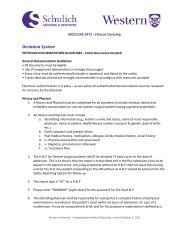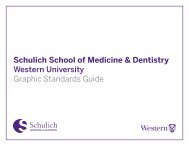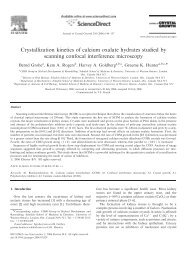A Duty to Certify Death:
A Duty to Certify Death:
A Duty to Certify Death:
Create successful ePaper yourself
Turn your PDF publications into a flip-book with our unique Google optimized e-Paper software.
A <strong>Duty</strong> <strong>to</strong> <strong>Certify</strong> <strong>Death</strong>:<br />
Compliance with the Coroner’s Act and <strong>Death</strong><br />
Certificate Completion<br />
Dr. Stephen Wetmore<br />
Vic<strong>to</strong>ria Family Medical Centre<br />
Coroner<br />
London Ontario
Objectives<br />
Review Coroner’s Act<br />
Coroner’s Investigations<br />
Completion of <strong>Death</strong> Certificates
Case 1<br />
JY, 85, CVA, right hemiplegia, aphasia<br />
Hypertension; atrial fibrillation<br />
Aspiration and aspiration pneumonia<br />
Herpes Zoster<br />
Sacral ulceration; infection<br />
Dehydration; unable <strong>to</strong> maintain nutrition<br />
Died while wife was feeding him
Case 1<br />
Your are the resident doc<strong>to</strong>r on call.<br />
Is this a coroner’s case?<br />
How would you complete the death<br />
certificate?
Reporting <strong>to</strong> a Coroner<br />
Patient dies in hospital<br />
MD <strong>to</strong> pronounce<br />
Is it a coroner’s case?<br />
Yes or not sure No<br />
Call coroner<br />
Coroner calls back<br />
Decides <strong>to</strong> investigate?<br />
Advise about body<br />
Advise about death certificate<br />
Ask next of kin for<br />
au<strong>to</strong>psy consent
Reporting <strong>to</strong> a Coroner<br />
Patient dies at home<br />
Expected death - MD or RN (EC)<br />
If no arrangements or unexpected coroner will be called<br />
Coroner <strong>to</strong><br />
investigate<br />
Coroner decides not <strong>to</strong><br />
investigate<br />
Family doc<strong>to</strong>r <strong>to</strong><br />
complete death<br />
certificate
CORONER SYSTEM - overview<br />
Ministry of Public Safety and<br />
Security - Ontario<br />
Chief Coroner - Ontario<br />
Investigation<br />
Coroner<br />
Regional Coroner<br />
Inquest Coroner
Office of the Chief Coroner<br />
Mission Statement:<br />
We speak for the dead <strong>to</strong><br />
protect the living
Coroner - Legislative Authority<br />
Coroner’s Act<br />
– <strong>Duty</strong> <strong>to</strong> Report – Section 10<br />
Coroner’s Amendment Act 2009<br />
– Establishes Ontario Forensic Pathology Service<br />
– Establishes <strong>Death</strong> Investigation Oversight<br />
Council and Complaints Committee<br />
– Establishes nature of coroner’s investigation<br />
» Answer the five questions<br />
» Decide on inquest<br />
» Focus on prevention of future deaths, similar circumstances
Coroner’s Investigation<br />
How do you know if you should report a<br />
death <strong>to</strong> a coroner?
THE CORONER’S ACT-1<br />
DUTY TO REPORT TO CORONER<br />
– violence<br />
– misadventure<br />
– negligence<br />
– misconduct, or<br />
– malpractice<br />
– by unfair means
THE CORONER’S ACT-2<br />
During pregnancy or following pregnancy<br />
suddenly and unexpectedly<br />
disease not treated by legal practitioner<br />
any cause other than disease<br />
under such circumstances as may require<br />
investigation
THE CORONER’S ACT-3<br />
while resident or inpatient of:<br />
– charitable institution<br />
– children’s residence<br />
– home for the aged<br />
– home for retarded persons<br />
– psychiatric facility<br />
– nursing home<br />
– any hospital if transferred from above sites
THE CORONER’S ACT-4<br />
Where a person dies while:<br />
– psychiatric patient<br />
– correctional institution<br />
– ward of the crown<br />
– cus<strong>to</strong>dy under Young Offenders Act<br />
– cus<strong>to</strong>dy of police or in prison
ROLE OF CORONER<br />
Investigate deaths reported under the Act<br />
– death scene<br />
– Examine the body<br />
– au<strong>to</strong>psy<br />
– seek other reports, e.g.. Fire marshal<br />
Report completion<br />
Inquest decision<br />
Coroner’s recommendations
Role of Coroner:<br />
Regarding the Body<br />
Warrant <strong>to</strong> take possession<br />
Identification of deceased<br />
Arrangement for au<strong>to</strong>psy<br />
Ensure no alteration of the body after death<br />
pending au<strong>to</strong>psy<br />
Authorizes release of body <strong>to</strong> funeral home<br />
Authorizes cremation
Role of Coroner:<br />
<strong>Death</strong> due <strong>to</strong> Trauma<br />
Make sure the events of the trauma are<br />
investigated - police investigation<br />
Au<strong>to</strong>psy is done in nearly all cases<br />
Blood may be seized for <strong>to</strong>xicology<br />
Records may be seized for later use
POWERS OF CORONER<br />
Enter and inspect locations<br />
inspect records or writings<br />
seize anything pertinent <strong>to</strong> investigation<br />
authorize other medical practitioners or<br />
police officers <strong>to</strong> exercise powers
CORONER’S REPORT<br />
Who the deceased was<br />
When the deceased died<br />
Where the deceased died<br />
How the deceased came <strong>to</strong> death (cause)<br />
By what means the deceased came <strong>to</strong> death<br />
(natural, accident, suicide, homicide, undetermined)
Coroner’s Investigations -<br />
Outcomes<br />
Coroner’s report communicated <strong>to</strong> family<br />
Coroner’s inquest<br />
Coroner’s recommendations<br />
– May recommend or ask for hospital review and<br />
report<br />
Regional supervising coroner’s review
Examine body and<br />
position<br />
evidence of trauma?<br />
pills, count<br />
alcohol, drugs<br />
suicide notes<br />
hanging apparatus<br />
SIDS – bedding<br />
DEATH SCENE<br />
INVESTIGATION<br />
Medical devices, moni<strong>to</strong>rs
Signs of <strong>Death</strong><br />
Lack of respirations, circulation<br />
Rigor mortis<br />
Lividity<br />
Decomposition
Lividity<br />
TIMING OF DEATH<br />
– Usually blue in colour<br />
– May be pink<br />
– Visible 30 min – 3 hr<br />
– Fully developed 8-12<br />
hr<br />
– Fixed , 12-15 hr.
Body temperature<br />
– 1 o /hr x 12hrs<br />
TIMING OF DEATH<br />
– 0.5 o /hr x 12 hrs<br />
S<strong>to</strong>mach contents<br />
– Variable and not helpful<br />
Rigor mortis<br />
– depends on various fac<strong>to</strong>rs<br />
– Starts immediately, gradual<br />
– Noticeable 3-4 hr.<br />
– Fully developed 8-12 hr
DEATH INVESTIGATION -<br />
Police reports<br />
Fire Marshall<br />
Dept. of Labour<br />
Aviation<br />
Centre Forensic<br />
Science<br />
Family doc<strong>to</strong>r<br />
Medical records<br />
OTHER
Completion of <strong>Death</strong> Certificates
Family Physician Responsibilities<br />
“The responsibilities of the family physician<br />
do not end with the death of the patient.<br />
Through careful and accurate completion of<br />
death certificates, the family physician can<br />
help <strong>to</strong> ensure that the far-reaching<br />
consequences of the patient’s death are as<br />
they should be.”<br />
Nowells D. Am Fam Physician 70<br />
(9);
Vital Statistics Act<br />
“Any legally qualified medical practitioner who<br />
has been in attendance during the last illness of the<br />
deceased person or who has sufficient knowledge<br />
of the last illness shall forthwith after the death<br />
complete and sign a medical certificate of death in<br />
the prescribed form, stating the cause of death<br />
according <strong>to</strong> the classification of diseases adopted<br />
by reference in the regulations, and shall deliver<br />
the medical certificate <strong>to</strong> the funeral direc<strong>to</strong>r or<br />
other person in charge of the body.”
<strong>Death</strong> Certificates -- importance<br />
Source of information for mortality<br />
statistics<br />
Potentially used by policymakers for public<br />
health goals, funding priorities, research<br />
May help settle estates of the deceased and<br />
allowing payments <strong>to</strong> beneficiaries
<strong>Death</strong> certificates -- evidence<br />
1993 survey of the house officers and<br />
family physicians<br />
90% of respondents felt accurate death<br />
certificate information was important<br />
> 50% felt that they needed more education<br />
in this skill.<br />
Maudsley et al J Public Health Med<br />
1993;15(2):192-201
<strong>Death</strong> certificates -- evidence<br />
1993, Jordan and Bass<br />
31.9% of death certificates at a tertiary<br />
teaching hospital contained errors<br />
The department of medicine had the highest<br />
rate of errors – 40% of certificates were<br />
classed as unacceptable<br />
Jordan and Bass. Clin Invest Med<br />
1993;16(4):249-55
<strong>Death</strong> certificates -- errors<br />
As as many as 30% of death certificates can have<br />
major errors<br />
Major errors generally fall in<strong>to</strong> two categories<br />
– Listing mechanism of death without underlying cause<br />
– Improper sequencing of death certificate information<br />
Myers at all showed an educational intervention<br />
significantly improved the major error rate in<br />
death certificates, but not the minor error rate.<br />
Myers and Farquhar. CMAJ<br />
1998;158:1317-23
<strong>Death</strong> Certificates<br />
Recommendations of the World Health<br />
Organization<br />
Part I; 3 lines, a,b,c, underlying cause of<br />
death, as well as immediate and antecedent<br />
causes<br />
Part II; other significant conditions<br />
contributing <strong>to</strong> the death
<strong>Death</strong> Certificates<br />
Underlying cause of death is the disease that<br />
triggered the chain of events leading <strong>to</strong> the<br />
patient’s death. – must be the lowest line of<br />
part I (from your knowledge of patient and<br />
circumstances – on balance of probabilities)<br />
An underlying cause of death can stand<br />
alone as the only completed line in part I<br />
Revised <strong>Death</strong> Certificates can be<br />
completed when further information is<br />
available
<strong>Death</strong> Certificates -- examples<br />
75-year-old male smoker, five year his<strong>to</strong>ry of<br />
emphysema, is admitted <strong>to</strong> hospital with<br />
pneumonia caused by Haemophilus influenza.<br />
Other his<strong>to</strong>ry includes 10 years of coronary artery<br />
disease.<br />
One week after admission, he is found dead in<br />
bed.<br />
You are called <strong>to</strong> complete the death certificate
Respira<strong>to</strong>ry Arrest Failure<br />
Coronary Artery Disease
<strong>Death</strong> Certificate -- examples<br />
Part I<br />
A) respira<strong>to</strong>ry arrest<br />
Part II<br />
Coronary artery<br />
disease<br />
Mechanism is listed<br />
without an underlying<br />
cause of death<br />
No time intervals are<br />
listed
Emphysema<br />
Pneumonia<br />
Coronary Artery Disease
<strong>Death</strong> Certificate -- examples<br />
Part I<br />
A) Emphysema<br />
B) Pneumonia<br />
Part II<br />
Coronary Artery<br />
Disease<br />
Improper sequencing<br />
Absence of time<br />
intervals
Emphysema 5 yr<br />
CAD 10 yr
<strong>Death</strong> Certificate -- examples<br />
Part I<br />
A) Emphysema 5 yr<br />
B) CAD 10 yr<br />
Part II<br />
Competing causes of<br />
death<br />
Abbreviations used
Pneumonia – Hemophilus Influenza 1 wk<br />
Emphysema 5 yr<br />
Coronary Artery Disease<br />
10 yr
<strong>Death</strong> Certificate -- examples<br />
Part I<br />
A) Haemophilus<br />
Influenza Pneumonia<br />
B) Emphysema<br />
Part II<br />
Coronary Artery Disease<br />
1 week<br />
5 years<br />
10 years
Examples - 1<br />
Mrs. Jones, age 75, suffered from<br />
rheuma<strong>to</strong>id arthritis for 25 years<br />
Two weeks ago, she fell and fractured her<br />
right hip. She was admitted had an<br />
arthroplasty.<br />
One week ago, she developed pneumonia<br />
and despite treatment died <strong>to</strong>day.<br />
You are called <strong>to</strong> pronounce death and<br />
complete death certificate
Pneumonia 1 wk<br />
Fall - Right hip fracture<br />
2 wks<br />
Rheuma<strong>to</strong>id Arthritis 25 yr
Examples - 2<br />
Mrs. K., aged 86, died in the nursing home<br />
after 10 days of intermittent vomiting and<br />
diarrhea.<br />
There was a gastrointestinal outbreak at the<br />
home. No etiologic agent was identified.<br />
She was admitted <strong>to</strong> the home five years<br />
earlier with advanced dementia.
Dehydration 10 d<br />
Viral Gastroenteritis<br />
Advanced Dementia<br />
10 d<br />
5 yr
Examples -- 3<br />
Mr. Y., aged 56, died at home, surrounded<br />
by family members after a long battle with<br />
cirrhosis of the liver caused by alcohol<br />
abuse<br />
For the last two weeks. He has been<br />
virtually unconscious, deeply jaundiced,<br />
and had a pronounced periodic jerking<br />
tremor
Hepatic Encephalopathy 2 wk<br />
Cirrhosis of Liver mths<br />
Alcohol Abuse<br />
years
Examples -- 4<br />
75-year-old man who had two heart attacks over<br />
the past eight years and is on antihypertensive<br />
medication and Lipi<strong>to</strong>r for 10 years is admitted<br />
after a fender bender accident in which he slid<br />
forward and impacted his chest in<strong>to</strong> the steering<br />
wheel.<br />
X-rays are negative for fracture. A CT scan shows<br />
no injury.<br />
Later that night he goes in<strong>to</strong> V. Tach, then V Fib<br />
and cannot be resuscitated.
Cardiac Arrhythymia Min.<br />
Chest Contusion Hrs<br />
Mo<strong>to</strong>r vehicle Accident<br />
Hrs<br />
Coronary Artery Disease 8 yr<br />
Hypertension yrs
Age 72, female<br />
Alcoholic<br />
Examples - 5<br />
Drinking heavily at friends<br />
Went <strong>to</strong> bathroom<br />
Found collapsed in BR 1 hr later<br />
PM – 75 % stenosis LAD
Complications of Coronary Artery<br />
Disease<br />
yrs<br />
Chronic Alcoholism Yrs.
Examples -6<br />
84 years, female, lives alone<br />
His<strong>to</strong>ry of hypertension, osteoarthritis<br />
Falls down 8 stairs, calls neighbour with<br />
alert but<strong>to</strong>n<br />
Hospitalized with fractured pelvis<br />
Dies in hospital 8 days later<br />
PM shows fat embolism, <strong>to</strong>xic level<br />
Verapamil
Fat Embolism 8 days<br />
Fractured Pelvis 8 days<br />
Fall down stairs<br />
8 days<br />
Possible Verapamil <strong>to</strong>xicity ?<br />
Hypertension Yrs
Examples -7<br />
95 year old female, lives alone<br />
Your patient for years; mild hypertension,<br />
some osteoarthritis, mild cognitive decline<br />
Carotid bruits; no CVA<br />
You have prescribed HCT but she doesn’t<br />
take it.<br />
Found dead in bed
Arteriosclerosis Yrs
Hypertension Yrs
Cerebrovascular Insufficiency Yrs
49 year old male<br />
Examples - 8<br />
Looked after at home by his wife<br />
Carcinoma of lung with brain and liver mets<br />
for 1 year<br />
You are making house calls, managing pain<br />
and symp<strong>to</strong>ms<br />
One morning you are called; he has died at<br />
home
Metastatic Carcinoma Lung – Small<br />
Cell<br />
1 yr
Case 1 - Reminder<br />
JY, 85, CVA, right hemiplegia, aphasia<br />
Hypertension; atrial fibrillation<br />
Aspiration and aspiration pneumonia<br />
Herpes Zoster<br />
Sacral ulceration; infection<br />
Dehydration; unable <strong>to</strong> maintain nutrition<br />
Died while wife was feeding him
Aspiration Pneumonia Days<br />
Cerebrovascular Accident years<br />
Decubitus Ulcer Wks
Key Points<br />
Don’t call the coroner for expected or natural deaths at<br />
home.<br />
Do call the coroner when the manner of death is not<br />
natural.<br />
Do be as accurate as possible based on your knowledge of<br />
the patient when completing death certificates<br />
<strong>Death</strong> certificates may be amended after they are<br />
completed.<br />
Old age is not a cause of death ( Ontario).<br />
Mechanism of death is not the same as a cause of death.<br />
<strong>Death</strong> due <strong>to</strong> a complication after a fall is an accident.


